-

人教版高中历史必修3新文化运动与马克思主义的传播说课稿
一、说教材(一)教材分析本课所介绍的新文化运动,是继上一节所学的《西学东渐和维新变法思想》之后中国另一波影响巨大的思想解放潮流,旨在向西方学习、寻求强国御侮之道。在整个知识体系中,它既是资产阶级领导的旧民主主义革命的补课,又是无产阶级领导的新民主主义革命的序曲。它所带来的思想的空前解放,也就为马克思主义的传播创造了条件,为中共的成立奠定基础。这一课的学习能让学生清晰认识新文化运动和马克思主义在近代中国思想解放历程中的重要作用和巨大影响。与必修一和必修二政治经济史的结合也能让使学生强化历史联系。新课程标准对本课就做了明确的规定:1、概述新文化运动的主要内容,探讨其对近代中国思想解放的影响。2、简述马克思主义在中国传播的史实,认识马克思主义对中国历史发展的重大意义。根据课标要求,我制定了以下具体的三维目标。
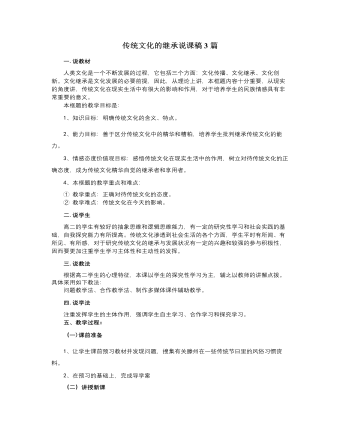
人教版高中政治必修3传统文化的继承说课稿3篇
(二)课堂教学在教学中,无论是形式还是内容,都必须统一于学生的发展。从形式上说,以学生展示、思考、讨论为主,教师点拨为辅,在一定的情境与社会文化背景下,获得对传统文化的认识和理解。从内容上说,主要以福州地方传统文化为素材,围绕海峡两岸同时举办的“元霄灯会”为主线,回归到学生的生活世界,更有效地激发起学生情感,并将生活世界与知识世界衔接起来,在实际情景中分析传授相关传统文化的知识,提高学生认识和分析解决问题的能力,逐步形成对传统文化的情感和价值判断。教学过程,紧紧围绕传统文化,分为“激趣导入--活动感悟--探究思辩--升华导行”四个层次,环环相扣,逐步推进,帮助学生完成由感性认识到理性认识的飞跃。1.激趣导入良好的开端是成功的一半。德国的普克朗认为:“思考可以构成一座桥,让我们通向新知识”。因此,一开始,我就运用对比方法,进行设问,福州和西安、南京、北京一样也是历史文化名城,你们同意吗?

人教版高中政治必修3色彩斑斓的文化生活说课稿3篇
根据课标要求,参照教科书,支撑这一问题解决的知识有:⑴文化生活的特点;⑵文化生活的两面性;⑶发展文化生活的基本要求。其中重点问题是辨别文化生活的“喜”与“忧”。只有辨别清楚,才能趋利避害,才能积极主动的参与健康向上的文化生活。从而为怎样发展为人民大众所喜闻乐见的文化打下基础。由于高二学生尚未学习哲学知识,所以它也是本节的一个难点,同时,由于学术界对什么是大众文化,大众文化有那些基本特征,存在着分歧,所以正确把握大众文化的含义也成为本节课的一个难点。三、学情分析:应该说高二学生已经参与了不少的文化生活。但由于其正处在三观形成的关键时期,对文化生活的参与还比较盲目,缺少理性思考,以至付出沉重的代价。很显然通过本框的学习,学生会更加理性的参与文化生活,从而健康茁壮的发展、成长。四、教学目标:基于以上分析,我将本框题的教学目标确定为以下三个方面:(1)知识目标:了解目前我国文化生活的现状,知道人们的文化生活是色彩斑斓的,但也存在令人忧虑的现象;把握大众文化的丰富内涵;明确发展为人民大众所喜闻乐见的文化必须坚持的原则、方针等。

人教版高中政治必修3色彩斑斓的文化生活说课稿
五、板书设计第一节色彩斑斓的文化生活一.当代文化生活素描(现状、原因)1、现状(1)文化生产:色彩斑斓(2)文化消费:多种选择2、当代文化生活色彩斑斓的原因有哪些?/当代人们在文化生活中为什么会面对多种选择?(1)现代科学技术(2)大众传媒(3)社会主义市场经济的发展(4)现代文化产业的发展二.文化生活中的“喜”与“忧”1、喜(1)表现①它能满足人们日趋多样化的文化需求,充实人们的精神生活②它可以通过灵活而有吸引力的表现方式,传播科学文化知识③它便于采取群众喜闻乐见的方式,使人们潜移默化地接受正确的价值观念,提高思想道德素质④它易于引导人们的消费观念,推动生产的发展(2)原因:文化市场和大众传媒的发展2、忧(1)表现①有些部门和单位在经济利益的驱动下,不顾社会效益,肆意生产、销售品位低下的文化产品
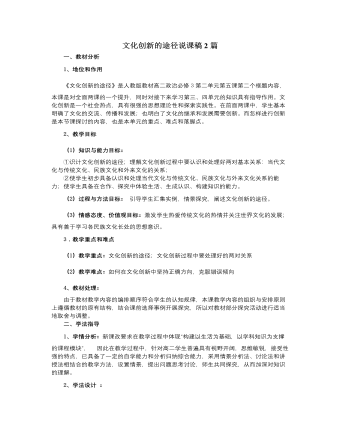
人教版高中政治必修3文化创新的途径说课稿2篇
PPT:文化创新的途径环节二:(展示情境 探究问题)情境一:先后展示徐悲鸿的《奔马图》和《愚公移山》设计意图:在作品的选择上遵循由易到难,由感性到理性的原则让同学们从中体会作者的创作情怀,比较两幅图表达的心境不同之处及其原因。探究一:从创作背景的不同,探究文化创新的根本途径。PPT:(设问)1、为什么同一画家在不同时期,作品所反映的内容不同?2、从中我们可看出,文化创新的根本途径是什么?设计意图:引导学生分析时代的变化对人们的社会实践的影响,因而文化工作者在体验生活的过程中创作的作品意境也会不同,培养学生透过现象看本质的能力,得出文化创新的根本途径是社会实践。教师过渡:在社会实践中,徐悲鸿先生还有什么创作的成功秘诀吗?探究二:从创作心得的展示,探究文化创新的重要途径(PPT)徐悲鸿一生致力于国画的创新实践,他认为革新中国绘画的要旨在于:“古法之佳者,守之;不佳者,改之;垂绝者,继之;未足者,增之;西方画之可采入者,融之。” 设计意图:通过阅读材料,培养学生寻找关键词的能力,并从中总结归纳文化创新的重要途径----继承传统、推陈出新。
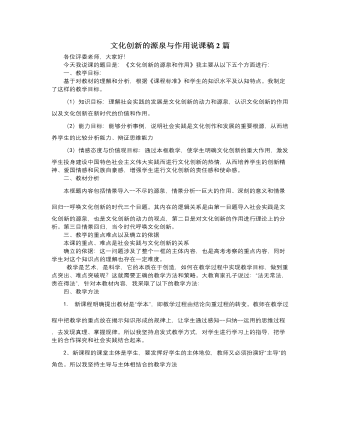
人教版高中政治必修3文化创新的源泉与作用说课稿2篇
一、教学目标:基于对教材的理解和分析,根据《课程标准》和学生的知识水平及认知特点。我制定了这样的教学目标。(1)知识目标:理解社会实践的发展是文化创新的动力和源泉,认识文化创新的作用以及文化创新在新时代的价值和作用。(2)能力目标:能够分析事例,说明社会实践是文化创作和发展的重要根源,从而培养学生的比较分析能力、辩证思维能力(3)情感态度与价值观目标:通过本框教学,使学生明确文化创新的重大作用,激发学生投身建设中国特色社会主义伟大实践而进行文化创新的热情,从而培养学生的创新精神、爱国情感和民族自豪感,增强学生进行文化创新的责任感和使命感。二、教材分析本框题内容包括情景导入--不尽的源泉,情景分析--巨大的作用、深刻的意义和情景回归--呼唤文化创新的时代三个目题。其内在的逻辑关系是由第一目题导入社会实践是文化创新的源泉,也是文化创新的动力的观点,第二目是对文化创新的作用进行理论上的分析。第三目情景回归,当今时代呼唤文化创新。
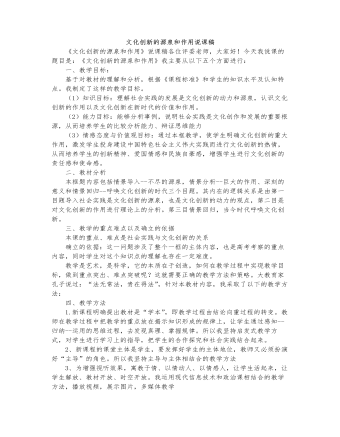
人教版高中政治必修3文化创新的源泉和作用说课稿
二、巨大的作用,深刻地意义材料展示:鲁迅在《狂人日记》中猛烈抨击“吃人”的封建礼教,力图通过自己的呐喊唤醒民众。高尔基早期的作品多描绘俄国沙皇制度下人民的痛苦和他们对美好生活的憧憬。20世纪初,俄国革命形势的发展使他讲文学的笔锋转向革命,创作了《母亲》等作品。合作探究:鲁迅和高尔基的作品在当时的中国和俄国分别起到了什么作用?列举喜爱的一些文学和艺术作品,说说创作者的意图是什么?引导学生自主阅读,培养自主学习能力,掌握分析归纳法和团结协作精神。学生回答之后师生共同总结:文化创新来源于社会实践,同也会对于社会实践产生新的影响,促进社会实践的变化,同时也繁荣了民族文化。所以文化创新的巨大作用一方面表现为推动社会实践的发展,另一方面表现为不断促进民族文化的繁荣。既然文化创新具有如此巨大的作用,那么作为新时代祖国的建设者为了繁荣民族文化,又该作些什么呢?进入本课第三目和教学的第三个环节。[情景回归参与生活]
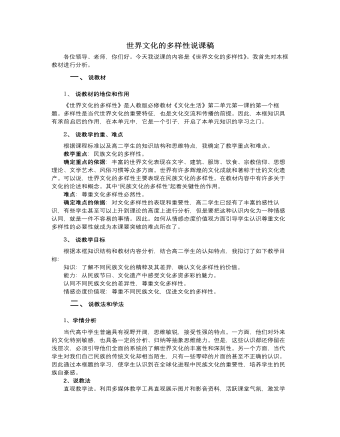
人教版高中政治必修3世界文化的多样性说课稿
1、 说教材的地位和作用《世界文化的多样性》是人教版必修教材《文化生活》第二单元第一课的第一个框题。多样性是当代世界文化的重要特征,也是文化交流和传播的前提。因此,本框知识具有承前启后的作用,在本单元中,它是一个引子,开启了本单元知识的学习之门。2、 说教学的重、难点根据课程标准以及高二学生的知识结构和思维特点,我确定了教学重点和难点。教学重点:民族文化的多样性。确定重点的依据:丰富的世界文化表现在文字、建筑、服饰、饮食、宗教信仰、思想理论、文学艺术、风俗习惯等众多方面。世界有许多辉煌的文化成就和著称于世的文化遗产。可以说,世界文化的多样性主要表现在民族文化的多样性。在教材内容中有许多关于文化的论述和概念。其中“民族文化的多样性”起着关键性的作用。难点:尊重文化多样性必然性。
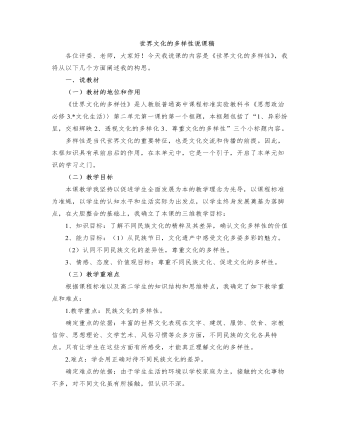
人教版高中政治必修3世界文化的多样性说课稿
设计意图:使同学从各届奥运会会徽的设计上看各国文化,让学生体会不同会徽体现的不同的民族文化,了解不同民族的文化特色,感悟文化多样性的价值,使学生产生情感认同,从而突破难点。探究活动5:教师多媒体呈现中法文化年的flash,显示中国到法国举办中国文化年的图片,比如:在法国街头出现了中国的京剧脸谱,中国孩子玩的风车,中国的大熊猫。出示法国到中国举办文化年的图片,比如:法国在北京举办的音乐会,法国空军的飞行表演等。学生讨论:中法文化年的举办对中法两国来说有什么现实意义?探究活动6:播放理查德.克莱德曼演奏的《梁山伯与祝英台》的视频讨论:(1)此曲吸引你之处在哪里?(2)由此可见,对待文化差异的正确态度是什么?活动5和活动6的设计意图在于让学生懂得,面对开放的世界,既要尊重本民族的文化,同时也要尊重其他民族的文化,从而突破难点。

人教版高中历史必修1资本主义政治制度在欧洲大陆的扩展说课稿
1789年法国大革命后,共和派与君主派之间进行了长期反复的斗争,直到1875年法兰西第三共和国宪法通过才最终确立了共和政体,它为法国资本主义的进一步发展奠定了基础。专制色彩浓厚的普鲁士通过王朝战争这种自上而下的形式,完成了德国的统一。1871年德意志帝国宪法颁布,德国君主立宪政体确立,保留了浓厚的专制残余和军国主义传统。但资产阶级代议制的建立使德国的资本主义工业迅速发展起来,19世纪末跻身到世界强国行列。资本主义政治制度扩展到了欧洲大陆,随着这两个国家资本主义政治制度的确立,近代西方主要资本主义政治制度得以最终确立。四、板书一、法国共和政体确立的艰难历程1、艰难 (1)表现 (2)原因2、确立标志:法兰西第三共和国宪法

人教版高中历史必修3建国以来的重大科技成就说课稿2篇
说教材(一)、本课在教材中的地位:教材在第3单元介绍了古代中国科技的辉煌。第四单元介绍世界近代科技成就,本课主要介绍了现代中国的科技成就。通过对本课的学习,有利于学生感受中国科技古代辉煌、近代落后、现代又取得很大成就这一重要历程,因此本课在教材中具有重要作用。(二)教学内容分析和课标要求:本课主要介绍新中国成立以来我国科学技术成就及作用。从核研究、航空技术、农业新品种研究、计算机应用、生物技术五方面介绍了新中国成立以来取得的举世瞩目的成就。课标对这部分知识作了如下的要求:列举新中国成立以来科技发展的主要成绩,认识科技进步在现代化建设中的重大作用。根据以上对教材内容的分析和课标要求,我将本课的三维目标确定如下:(三)、教学目标1、知识与能力:识记建国后六十多年来所取得的科技成就;理解科学技术是生产力的论断;探究科技的发展在现代化建设中的重要作用。

人教版高中历史必修3物理学的重大进展说课稿2篇
二、相对论的创立【课件】展示下列材料艾伯特·爱因斯坦(1879——1955),1879年3月14日诞生在德国乌尔姆的一个犹太人家中。1894年举家迁居意大利米兰。1900年毕业于瑞士苏黎世工业大学。爱因斯坦被认为是最富于创造力的科学家,他不但创立了相对论,还提出了光量子的概念,得出了光电效应的基本定律,并揭示了光的波粒二重性本质,为量子力学的建立奠定基础。为此荣获1921年度的诺贝尔物理学奖。同时,他还证明了热的分子运动论,提出了测定分子大小的新方法。【问题】19世纪末20世纪初爱因斯坦对物理学的贡献是什么?意义是什么?为什么会出现?1、背景:经典物理学的危机。19世纪末三大发现:x射线、放射性和电子,经典力学无法解释研究中的新问题,如:黑体辐射、光电效应等。2、相对论的提出及主要内容:(1)“狭义相对论”和光速不变原理:1905年提出。
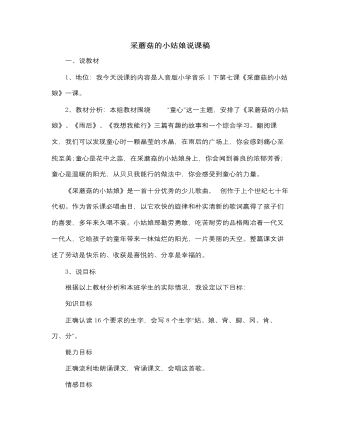
人音版小学音乐一年级下采蘑菇的小姑娘说课稿
(三)精读感悟1.独立阅读,自主探究。出示中心问题:这是一个---- 的小姑娘。?是从哪些地方看出来的?找出有关语句并体会着读一读。这一环节充分体现了学生“自主、合作、探究”的学习方式。教师为学生提供了宽广的学习空间。学生围绕中心问题,自己确定重点研究的内容,自由选择最适合自己的学习方式,在课文中摄取相关的语言信息。预设1这是一个勤劳的小姑娘,从第一小节看出。预设2这是一个善良的小姑娘,第二小节看出。引导学生找出相关的语句用自己的话说一说。设计意图1用尊重学生独特的见解和感受。让学生去关心文本中的人物,鼓励他们发表自己的想法,在品味中感受小姑娘的勤劳、善良故事表演情感升华2、学唱歌曲。帮助学生记忆课文。3、学完本课文后提问你最想说的一句话什么?你想对小姑娘说什么?达成情感目标。(四)达标测评(3)读一读,然后用“像”写句话。1.她采的蘑菇最多,多得像那星星数不清。2.她采的蘑菇最大,大得像那小伞装满筐。
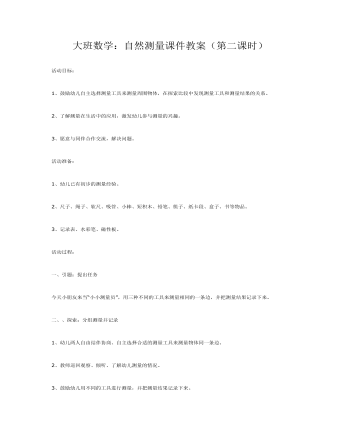
大班数学:自然测量课件教案(第二课时)
2、了解测量在生活中的应用,激发幼儿参与测量的兴趣。3、愿意与同伴合作交流,解决问题。活动准备:1、幼儿已有初步的测量经验。2、尺子、绳子、软尺、吸管、小棒、短积木、铅笔、筷子、纸卡段、盒子、书等物品。3、记录表、水彩笔、磁性板。活动过程:一、引题:提出任务今天小朋友来当“小小测量员”,用三种不同的工具来测量相同的一条边,并把测量结果记录下来。

新人教版高中英语必修2Unit 1 Cultural Heritage-Discovering Useful Structure教案二
This theme of the part is “ Describe people or things in greater detail”. Students have learned the grammar(restrictive relative clauses) in Book 1, and further review and consolidate its structure “prep+relative pronouns(which/whom)” and the relative adverbs(when, where and why), besides students should understand its form, meaning and functions. In this section, students should be able to express the grammar correctly in daily communication and in the writing. 1. Review the basic usages of relative pronouns and adverbs of attributive clauses . 2. Learn to use some special cases about restrictive relative clauses.3. Learn to write sentences with restrictive relative clauses flexibly according to the context.1. Review the basic usages of relative pronouns and adverbs of attributive clauses .2. Learn to use some special cases about restrictive relative clauses.3. Learn tow rite sentences with restrictive relative clauses flexibly according to the context.Step 1. Observe the following sentences, and mark the relative pronouns and the adverbs. 1. After listening to the scientists who had studied the problems, and citizens who lived near the dam, the government turned to the United Nations for help.2. Temples and other cultural sites were taken down piece by piece, and then moved and put back together again in a place where they were safe from the water.Step 2 PracticePlease complete these sentences with relative pronouns and relative adverbs and answer the following questions.Questions: 1. What is the head noun ?2. What relative words should be used ?3. What elements do they act in these sentences ?

新人教版高中英语必修2Unit 2 Wildlife Protection-Reading for Writing教案二
This lesson aims at making a poster about protecting wildlife after reading some posters. During reading students are guided to understand the content and try to summarize the posters with one sentence. Then students are guided to try to make a poster about protecting wildlife.1. Read the two posters and try to understand the summary sentences.2. Look at the two posters and try to understand what emotions they express.3. Try to summarize the features of posters4. Try to make a poster about wildlife.1. Look at the two posters and try to understand what emotions they express.2. Try to summarize the features of posters3. Try to make a poster about wildlife.Step 1 Lead inLook at the the posters on the textbook and ask:Which emotions do the posters communicate ?Step 2 Read the poster and answer the questions.1. What do you think of the animals in the poster on the left ?I think it is frightening and ugly.2. Why do we should protect the ugly animals ?All species--the good, the bad, and the ugly-- should be treated equally.The world needs all kinds--without variety, our planet cannot survive.3. Why are billions of trees being cut down every year ?To make paper for humans.4. What result will be lead to after the trees are cut down ?A lost of animal homes are being destroyed./The habitat of wildlife is being destroyed.Step 3 Find the feature of posters1. What does each poster use to stir up emotions ?On the left, it makes us a little frightened and it looks a little ugly, but it can activate our curiosity--What is it? And What is wrong with it?On the right, it makes us feel a little sad and want to protect them.

新人教版高中英语必修2Unit 1 Cultural Heritage-Reading and Thinking教案二
1. This section focuses on "Understanding how a problem was solved”, which is aimed to guide students to analyze and discuss the challenges and problems faced by cultural heritage protection during the construction of Aswan Dam, as well as the solutions. On the basis of understanding, students should pay attention to the key role of international cooperation in solving problems, and attach importance to the balance and coordination between cultural heritage protection and social and economic development. Students are encouraged to face challenges actively, be good at cooperation, and make continuous efforts to find reasonable ways and means to solve problems.2. Enable students to understand the main information and text structure of the reading text;3. Motivate students to use the reading strategy "make a timeline" according to the appropriate text genre;4. Enable students to understand how a problem was solved;5. Enable students to understand the value of protecting cultural heritage by teamwork and global community;1. Guide students to pay attention to reading strategies, such as prediction, self-questioning and scanning.2. Help students sort out the topic language about protecting cultural relics and understand the narrative characteristics of "time-event" in illustrative style3. Lead students to understand the value of protecting cultural heritage by teamwork and global community;

新人教版高中英语必修2Unit 2 Wildlife Protection-Discovering Useful Structure教案二
2.表示现阶段正在进行的被动动作(该动作在说话的瞬间未必正在进行)。Many interesting experiments are being carried out these days.(说话时,并不一定正在进行)3.表示一种经常性的被动行为,常和always,constantly 等表示频度的副词连用,这种用法常常带有赞扬或厌恶的感情色彩。He is always being praised by the leader.4.表示按计划或安排主语将要承受谓语动词所表示的动作(仅限于少数及物动词)。A party is being held tonight.Step 4 Special cases1.像take care of, look after, talk about, think of等动词与介词构成的短语用于现在进行时的被动语态时, 其中的介词不可省略。The ways to stop illegally hunting are being talked about. 2.可与部分情态动词连用,表示对正在发生的事情的推测。She may be being punished by her mother.3.有时可表示按计划或安排将要进行的一个被动动作。A celebration is being held this weekend for his success.4.某些表示“状态、心理活动、存在”等的动词,如have,want,need,love,一般不用现在进行时的被动语态,而常用一般现在时的被动语态。With the population increasing,more land is needed.5.“be+under/in+n.”可表示现在进行时的被动意义。My computer is under repair.=My computer is being repaired.

新人教版高中英语必修2Unit 2 Wildlife Protection-Reading and Thinking教案二
The theme of this unit is human and nature, focusing on the theme of wildlife protection. Nature is a complex ecosystem, in which there are delicate balance between animals and plants. Because of the role of the food chain, the extinction of one species will produce influence, causing a series of chain reaction. Large scale extinction of species will have a serious and even irreversible impact on the ecosystem, resulting in immeasurable losses. Therefore, it is of great significance to protect wild species. To protect wild species is to protect human beings themselves. The motto of this unit is "when the buying stops, the killing can too,” which is a public service advertising slogan to protect wildlife. It tells people that every rhinoceros horn, every fur, every bowl of shark fin soup, every Ivory product, and every tiger bone product, etc. consumed by human beings, are innocent wild animals slaughtered behind them. The mission of wild aid is to ban illegal trade in endangered wildlife and mitigate climate change. It aims to educate the public to reduce the consumption demand for endangered wildlife products through public publicity and improve the awareness of environmental protection.1. Improve the awareness of wildlife protection by acquiring the knowledge of wildlife protection.2. Focus on environmental protection and protection of all lives.3. Analysis of the living environment of wild animals with appropriate thinking mode.4. Skillfully use the vocabulary and grammar knowledge of this unit to cultivate self-study ability according to the unit content5. Develop cooperative learning ability through discussion and other ways1. Enable the Ss to talk about the current situation of wild animals.2. Guide the Ss to summarize the main idea of each paragraph as well as the main idea of the text.

新人教版高中英语必修2Unit 3 The Internet-Discovering Useful Structure教案二
This teaching period mainly deals with grammar “The Present Perfect Passive Voice.” To begin with, teachers should lead students to revise what they have learned about the Present Perfect Passive Voice. And then, teachers move on to stress more special cases concerning this grammar。This period carries considerable significance to the cultivation of students’ writing competence and lays a solid foundation for the basic appreciation of language beauty. The teacher is expected to enable students to master this period thoroughly and consolidate the knowledge by doing some exercises. 1. Guide students to review the basic usages of the Present Perfect Passive Voice2. Lead students to learn to use some special cases concerning the Present Perfect Passive Voice flexibly.2. Enable students to use the basic phrases structures flexibly.3. Strengthen students’ great interest in grammar learning.1. Help students to appreciate the function of the Present Perfect Passive Voice in a sentence2. Instruct students to write essays using the proper the Present Perfect Passive Voice.观察下列句子特点,总结共同点。1.(教材P28)Much has been written about the wonders of the World Wide Web.2.(教材P28)But the Internet has done much more for people than simply make life more convenient.3.(教材P28)Many people have been helped by the club.4.(教材P28)She no longer feels lonely, and her company has become quite successful.5.(教材P32)Today I thought I’d blog about a question that has been asked many times—how do you stay safe online and avoid bad experiences on the Internet?